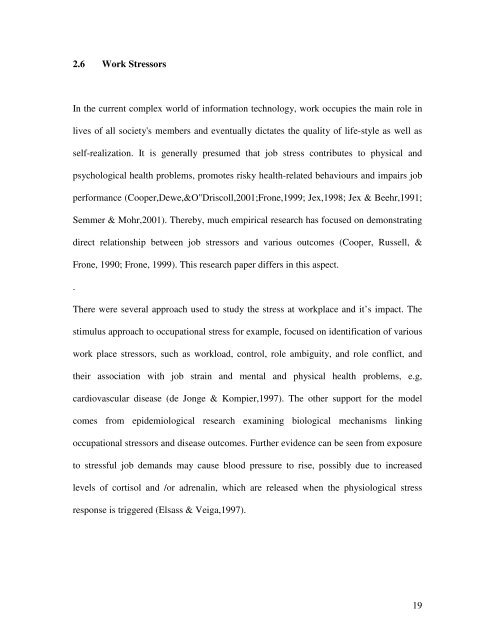1 CHAPTER 1 INTRODUCTION 1.0 Overview Over ... - DSpace@UM
1 CHAPTER 1 INTRODUCTION 1.0 Overview Over ... - DSpace@UM
1 CHAPTER 1 INTRODUCTION 1.0 Overview Over ... - DSpace@UM
Create successful ePaper yourself
Turn your PDF publications into a flip-book with our unique Google optimized e-Paper software.
2.6 Work StressorsIn the current complex world of information technology, work occupies the main role inlives of all society's members and eventually dictates the quality of life-style as well asself-realization. It is generally presumed that job stress contributes to physical andpsychological health problems, promotes risky health-related behaviours and impairs jobperformance (Cooper,Dewe,&O"Driscoll,2001;Frone,1999; Jex,1998; Jex & Beehr,1991;Semmer & Mohr,2001). Thereby, much empirical research has focused on demonstratingdirect relationship between job stressors and various outcomes (Cooper, Russell, &Frone, 1990; Frone, 1999). This research paper differs in this aspect..There were several approach used to study the stress at workplace and it’s impact. Thestimulus approach to occupational stress for example, focused on identification of variouswork place stressors, such as workload, control, role ambiguity, and role conflict, andtheir association with job strain and mental and physical health problems, e.g,cardiovascular disease (de Jonge & Kompier,1997). The other support for the modelcomes from epidemiological research examining biological mechanisms linkingoccupational stressors and disease outcomes. Further evidence can be seen from exposureto stressful job demands may cause blood pressure to rise, possibly due to increasedlevels of cortisol and /or adrenalin, which are released when the physiological stressresponse is triggered (Elsass & Veiga,1997).19
















